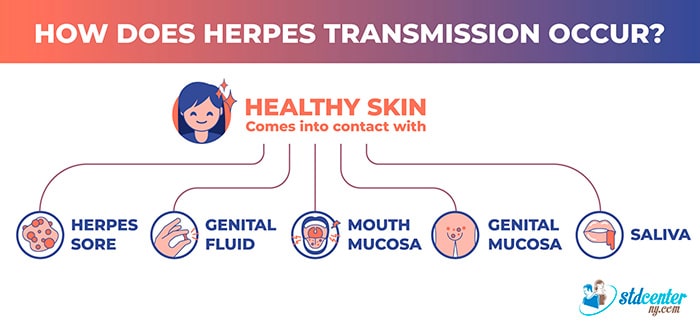Chance of Getting Herpes When a Partner Has Symptoms
The risk of transmitting the herpes virus is greatest when the infected individual displays symptoms, with an approximate probability of 20.1% per year.
What Does Symptomatic Mean?
A person is considered symptomatic when they first experience the prodromal period, which includes fever, chills, fatigue, muscle aches, localized skin tingling, and flu-like symptoms. Following this period, skin lesions develop, initially appearing as redness that progresses to blisters and sores. An individual remains symptomatic until all skin lesions have completely healed, which occurs a few days after the crusts fall off.
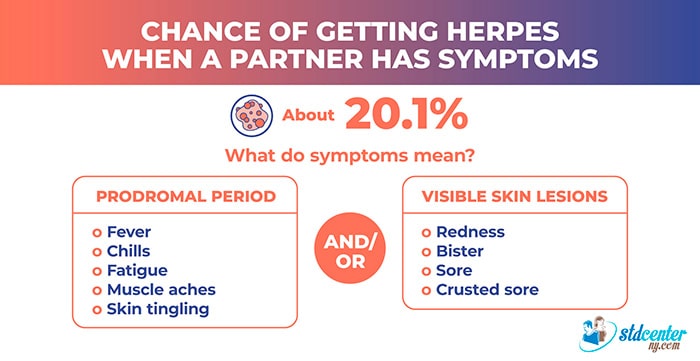

Chance of Getting Herpes from an Asymptomatic Partner
When it comes to the risk of contracting herpes from a partner who displays no symptoms, the chance is relatively low, approximately 4-10% per year. However, studies suggest that approximately 70% of herpes cases stem from asymptomatic virus shedding. [1] Transmission of genital herpes in couples with one symptomatic and one asymptomatic partner: a prospective study https://pubmed.ncbi.nlm.nih.gov/2836518/
Understanding Asymptomatic Virus Shedding
Asymptomatic virus shedding refers to the release of the virus from an infected person who exhibits no visible signs or symptoms of the disease. The likelihood of transmission increases with the concentration of virus shed. This shedding is not continuous; it occurs episodically and can last anywhere from 12 hours to 3 days. Interestingly, the frequency and duration of shedding tend to be higher immediately after the initial infection and gradually decrease over time.
[4]
Persistent Genital Herpes Simplex Virus-2 Shedding Years Following the First Clinical Episode
https://www.ncbi.nlm.nih.gov/pmc/articles/PMC3058740/#:~:text=Total%20HSV%20genital%20shedding,-The%20overall%20percentage&text=HSV%20shedding%20occurred%20on%2033.6%25%20of%20days%20among%20participants%20%3C1,Table%202%20and%20Figure%202).
For those infected with the HSV-2 virus, shedding occurs about 30% of the days in a given timeframe. [2] Risk of acquisition of genital herpes simplex virus type 2 in sex partners of persons with genital herpes: a prospective couple study https://pubmed.ncbi.nlm.nih.gov/8383724/
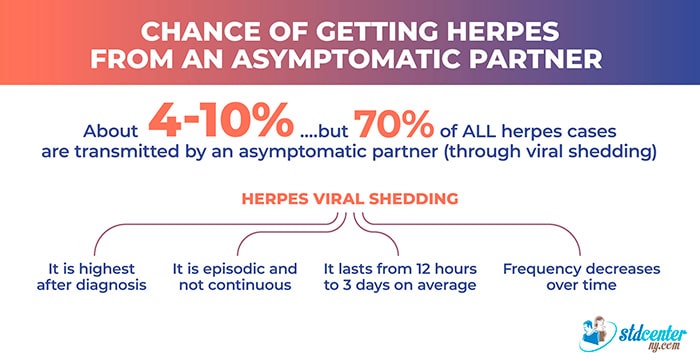

Herpes Transmission Probability with Unprotected Sex
The probability of transmitting herpes during unprotected sex varies across studies, ranging from approximately 3% to 10% per sexual act. This risk is notably higher for females.
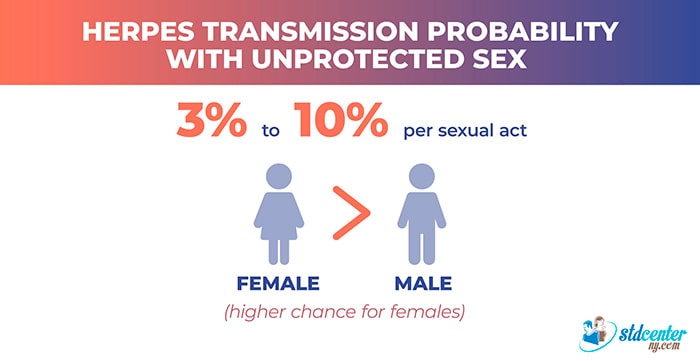

Herpes Transmission Probability with Protection (Condom Use)
Using a condom significantly reduces the likelihood of herpes transmission compared to unprotected sex, with probabilities estimated at 0.08% to 0.25% per sexual act. Condom use decreases the risk of herpes acquisition by 96% from men to women and by 65% from women to men. [3] Effect of Condom Use on Per-act HSV-2 Transmission Risk in HIV-1, HSV-2-discordant Couples https://pubmed.ncbi.nlm.nih.gov/26578538/#:~:text=Results%3A%20Transmission%20of%20HSV%2D2,per%201000%20unprotected%20sex%20acts
However, a 2010 study by Emily T. Martin and colleagues indicates that there is still a risk of herpes transmission even during protected sex without visible outbreaks, provided that one partner is herpes positive. This occurs because herpes can be transmitted through skin-to-skin contact or skin-to-mucosa contact. Areas of the genitals not covered by condoms remain susceptible to herpes exposure.
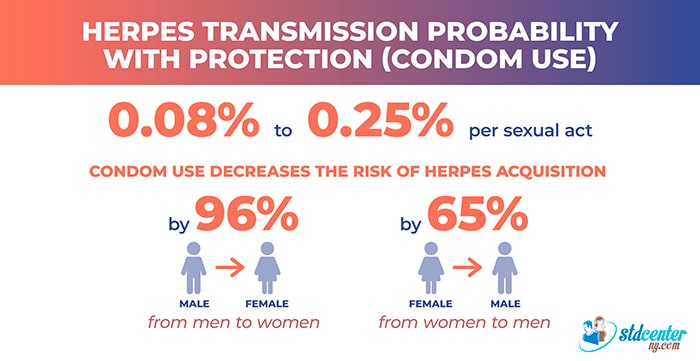

Chances of Getting Herpes from an Infected Partner on the Medication
Daily antiviral medications (Acyclovir, Famciclovir, and Valacyclovir) are well-known remedies for shortening a herpes outbreak, but they can also serve as preventive measures to reduce the spread of herpes.
They decrease the likelihood of herpes transmission by about 50%.
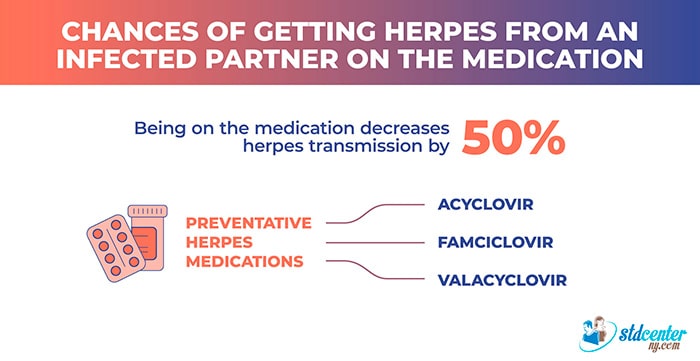

Chance of Contracting HSV-2 Through Oral Sex
The likelihood of transmitting HSV-2 to an uninfected partner through oral sex is low. Why? Typically, HSV-2 causes genital herpes, as its name suggests. It usually resides in the genital area of the body—specifically, in the sacral ganglia (a collection of sensory nerves)—when not causing outbreaks; this is where it tends to remain.
However, when HSV-2 infects the oral region, it typically localizes in the trigeminal ganglia of the skull. When the HSV-2 virus occupies this uncommon location, the likelihood of recurring symptoms and asymptomatic shedding is low.
Chance of Getting HSV-1 Genitally
Unlike HSV-2 transmission orally, HSV-1 transmission genitally can occur, although it remains infrequent.
Similar to the HSV-2 virus, HSV-1 tends to remain in its typical location (the trigeminal ganglia of the head) between outbreaks. The likelihood of transmission decreases when it is located in the genital area.
Since most herpes transmissions occur between outbreaks with virus shedding, HSV-1 shedding from the genital area is 11%, compared to 37% in the oral region.
What are the Chances of Getting Herpes from a Woman?
The transmission rate of genital herpes from an infected female to a healthy male is 4% over one year.
What are the Chances of Getting Herpes from a Man?
The rate of transmission of genital herpes from an infected male to a healthy female is 7%–31% over one year.
This higher transmission rate from man to woman is due to the herpes virus being more easily spread through the mucosa (the moist inner lining of some organs, such as the vagina) rather than through “regular” skin. Additionally, females have a larger exposed area of mucosa (the vagina) in their genital region compared to men (the penile urethra).
FAQ
Can you be exposed to herpes and not contract it? ›
Is herpes less contagious over time? ›
How can you prevent herpes after exposure? ›
Source
-
Transmission of genital herpes in couples with one symptomatic and one asymptomatic partner: a prospective study
https://pubmed.ncbi.nlm.nih.gov/2836518/ -
Risk of acquisition of genital herpes simplex virus type 2 in sex partners of persons with genital herpes: a prospective couple study
https://pubmed.ncbi.nlm.nih.gov/8383724/ -
Effect of Condom Use on Per-act HSV-2 Transmission Risk in HIV-1, HSV-2-discordant Couples
https://pubmed.ncbi.nlm.nih.gov/26578538/#:~:text=Results%3A%20Transmission%20of%20HSV%2D2,per%201000%20unprotected%20sex%20acts -
Persistent Genital Herpes Simplex Virus-2 Shedding Years Following the First Clinical Episode
https://www.ncbi.nlm.nih.gov/pmc/articles/PMC3058740/#:~:text=Total%20HSV%20genital%20shedding,-The%20overall%20percentage&text=HSV%20shedding%20occurred%20on%2033.6%25%20of%20days%20among%20participants%20%3C1,Table%202%20and%20Figure%202). -
Herpes simplex virus: global infection prevalence and incidence estimates, 2016
https://pubmed.ncbi.nlm.nih.gov/32514197/ -
Herpes simplex virus type 2 transmission: risk factors and virus shedding
https://pubmed.ncbi.nlm.nih.gov/15319082/
